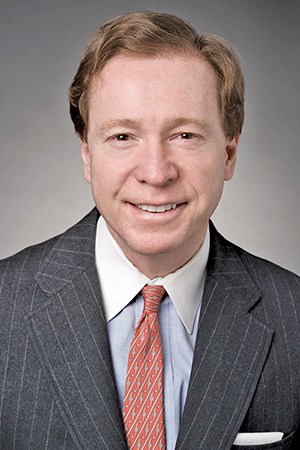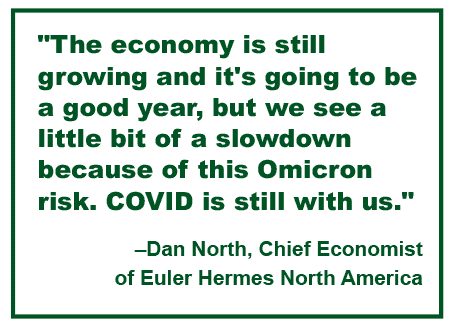
The economy is expected to grow by almost 4 percent in 2022, much higher than the 2.2 percent rate over the past 20 years. But significant risks to the economy exist as well. Those were the recent statements by Dan North, Chief Economist of Euler Hermes North America, during a webcast panel discussion.
His overall presentation regarding the U.S. economy was promising and highlighted harbingers of real strength while also delving into challenging issues.
Let’s take a deep dive into some of these topics presented by North.
The government’s stimulus benefits and consumer spending: North said the economy’s key driver is cash savings provided by consumers and their ability to spend (comprising fully 70 percent of personal consumption). “Spend, they did,” North observed. “More importantly, they still have plenty to spend and the willingness to do so.”
In fact, personal consumption expenditures at the time of this webinar were up 26 percent since May 2020 and up 11 percent from pre-COVID. Consumer confidence in the economy remains strong at this time.
Manufacturing index and orders for durable goods: New orders for goods currently are rated at 60.4, which is a strong economic indicator, versus a historical average of 55. Anything above 50 means expansion in the economy. This means plenty of work is in the pipeline as consumers turn loose of cash, outpacing pre-COVID years. In fact, back orders are very high – in the top 4 percent of all observations going all the way back to World War II.
Also, North said ISM (Institute of Supply Management) Services data, which is another important metric to follow, reports that 80 percent of the economy’s backlog of orders is high, in the top two percent ever recorded. They rate new orders at 61.5, again indicating plenty of work in the pipeline in the coming future.

Positive Treasury Yield Curve: The economy is receiving strong signals about its potential health over the next year. The Treasury Yield Curve is a harbinger of that and it is in positive territory. North explained the Treasury Yield Curve is the difference between the 10-year interest rate and the three-month interest rate. North presented data that showed in the U.S. history how recovery has followed downturns. For example, 1973-1974, the economy faltered but a recovery followed. In 2008-2009, the Great Recession was followed by a steady recovery.
Today, North said that signs point with “a great deal of confidence” to a recovery post-COVID. The economy is in “very positive” territory, remarked North. “We will have continued growth for the next three to five quarters and the numbers create a very compelling chart of that potential expansion.”
Another leading indicator of economic growth, said North, is that business formations “have skyrocketed” since COVID’s onset in 2020. Business application totals are up 44 percent from pre-COVID. That equals more work in the pipeline, too.
JP Morgan Credit Card Tracker and Omicron: North noted consumer stimulus spending can be credited with bringing the economy back to life post-2020. What has occurred this year, though, shows the potential impact of continued COVID variant impacts. The JP Morgan Credit Card Tracker is a significant real-time barometer of the economy. As of Jan. 17, 2022, it still trailed by two percent pre-COVID levels. Then a week later, the tracker took a sharp downturn.
Why?
“Omicron had something to do with that,” explained North. As the new COVID surge soared, spending spiraled downward a bit.
To dine out or not to dine out…Omicron-impacted: At the time of this webinar, dining out numbers were still 25 percent below pre-pandemic months, noted North. “The restaurant industry actually returned to above pre-pandemic levels, and then consumer spending went down recently,” he commented. Meanwhile, hotel occupancy rose above pre-pandemic levels briefly, but began sliding downward. North speculated that the Omicron COVID surge was adversely impacting both the restaurant and the hotel industries, and the Delta variant prior to that.
To be clear, North said, “The economy is still growing and it’s going to be a good year, but we see a little bit of a slowdown because of this Omicron risk. COVID is still with us.”
The problem of easy money and 0 interest rate: “Too much easy money causes inflation,” cautioned North, who pointed to the $5 trillion in stimulus checks that added 22 percent to the national debt/GDP ratio.
He cautioned that the Fed’s loose policy of 0 percent interest rate coupled with easy money for too long is the classic formula for inflation. “It’s a classic mistake by central banking, in my opinion,” he added.
In years past, the Feds Fund rate has risen as high as 10-20 percent. In the Great Recession it was set to 0, and was raised thereafter. Then, along came COVID, and the rate was set back to 0.
This is contributing to inflation, “and this will eventually lead to tears,” said North, unless corrective steps are taken by the Fed to raise rates.
To that end, North cited the Taylor rule, which is a formula that is used to predict or guide how central banks should alter interest rates due to changes in the economy. Taylor’s rule recommends that the Federal Reserve should raise interest rates when inflation or GDP growth rates are higher than desired. North explained that since inflation now is high, the Taylor rule suggests the Fed Funds rate should be closer to 6 or 7 percent, not the 0.13 percent (current percentage available at the time of this writing). Markets at the time of the webinar had four rate hikes fully priced in and North said there were hints creeping in of more than four, possibly as much as 50 bps (Basis Points) in March 2022. (If you reference the ISM Manufacturing Prices, more than 50 bps means prices are still rising.) As the first of February 2022 drew near, North stated that services hit their second highest bps ever at 82.5. Meanwhile, manufacturing was strong at 68.2 (average has been 62).
Let’s talk about labor: North calls wages “sticky.” That’s because, as he explained, once they go up, they don’t easily come down. Hourly wages in the three months prior to his webinar soared to a record high, climbing 4.8 percent. Some business owners indicated they plan to raise compensation in the next three months.
“Demand is soaring, but actual hirings are very low,” North stated. He cited 10.8 million job openings at the time of this writing compared with 6.6 million job hirings.
Simultaneously, the U.S. is experiencing a record high rate of workers quitting their jobs.
Why?
North named the following as reasons workers have exited their jobs in record numbers:
•They found a new job.
•Lack of child care.
•They started their own business.
•They retired. (Some studies estimate 2-3 million people retired early. Note: the economy still has 4 million fewer jobs than it did before COVID.)
•They quit their jobs due to fear of COVID in the workplace.
So, what’s fueling rising prices across all industries? North presented comments collected from ISM participants, and each cited, in some variation, supply chain issues, scarcity of trucks, labor challenges, all of which lead to price increases and are a complex issue with no simple or quick solutions.
Boats on the water: During a two-day span prior to North’s webinar, 133 container ships waited at berth inside the 40-mile radius of the Los Angeles/Long Beach ports plus outside SAQA (the Safety and Air Quality Area). The situation reached an all-time single-day high on Jan. 9 this year when 109 were floating inside the LA/LB area. Lastly, one day prior to North’s webinar, total container ship backup was 106, three more than just the day prior to that. This backlog stymies the supply chain.
North stated that participants of an ISI/Evercore survey believe it will be the second half of 2022 – or later – until the supply chain is potentially considered “cleared up.”
Trucking woes: “There simply are not enough trucks to take shipments from the ships and on the road,” North noted. Trucking employees remain 18 percent fewer today in the workforce than pre-pandemic. That equates to 15,800 fewer truck drivers now than just three years ago to haul product. “Due to this,” acknowledged North, “the inventory/sales ratio just keeps falling.” The result is that inflation and supply chain shortages are connected.
The Omicron Effect:
At the time of North’s webinar, Omicron comprised fully 98 percent of new daily confirmed cases of COVID. U.S. cases rose six times in less than one month. In France, it rose 10 times in about six weeks. Next, consider the daily new confirmed cases by millions (in population). The U.S. rate was turning down at the time of this writing. But concerns were rising over potentially more lockdowns in Europe. As North noted, “The economic concern is: if it can happen there, will it happen here?”
COVID deaths and hospitalization figures lag behind daily new confirmed case data. North pointed out that at the time of his webinar, confirmed deaths from Omicron in the U.S. were rising, and when considering confirmed deaths per million, “the U.S. looked a lot better a few weeks ago,” he observed. He added that the U.S. led other countries in confirmed deaths per million.
His next concern for the North American economy is vaccine-related. “Canada is doing very well in regard to the share of its population that is fully or partially vaccinated,” he stated. “But the U.S. is stuck at 75 percent vaccination rate because our daily vaccination rate has plummeted. We have to wonder: have we gotten almost all the people vaccinated we are going to get?”
Lastly, here is the good news:
•Fiscal and monetary policies have provided plenty of excess savings to fuel personal consumer consumption in 2022.
Other harbingers of economic strength are:
•Plenty of work in the pipeline
•Consumer confidence
•Positive yield curve
•Surging business formations
•Improvements in the labor market
North expects the economy to grow by almost 4 percent in 2022, much higher than the 2.2 percent rate over the past 20 years.
But significant risks are:
•Rising wages, the labor shortage and clogged supply chain
•Combined with loose fiscal and monetary policy, thus inflation roars
•COVID…it is still with us.
(Editor’s Note: Dan North has been with Euler Hermes North America since 1996, using macroeconomics and quantitative analyses to help manage Euler’s risk portfolio of more than $150 billion in annual U.S. trade transactions. As an economist he has appeared on CNBC, Fox Business News, France 24, The Street and Bloomberg Radio and Television. He has been quoted by Barron’s, Business Week, Paris La Monde, Tokyo Nikkei, the BBC, The New York Times and the Wall Street Journal. After having predicted the 2008/2009 recession and its implications accurately, he was ranked 4th on Bloomberg’s list of the 65 top economic forecasters in 2010. North holds an MBA from the Wharton School of Business. At the recent webinar, in addition to North, Gerry Clancy, National Tax Practice Lead at Top 20 CPA firm, Armanino, presented focused information on corporate/business taxes. The panel was moderated by Lindy Antonelli, Controllers Council™ Board Chair and Partner, Armanino Technology.)








